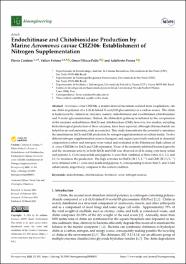“Endochitinase and Chitobiosidase Production by Marine Aeromonas caviae CHZ306: Establishment of Nitrogen Supplementation“

View/
Download
(application/pdf: 1.658Mb)
(application/pdf: 1.658Mb)
Date
2023-03-29Author(s)
Cardozo, Flavio
Feitosa, Valker
Pillaca-Pullo, Omar
Pessoa, Adalberto
Metadata
Show full item recordAbstract
“Aeromonas caviae CHZ306, a marine-derived bacterium isolated from zooplankton, can
use chitin (a polymer of a β-(1,4)-linked N-acetyl-D-glucosamine) as a carbon source. The chitin
is hydrolyzed by chitinolytic enzymes, namely endochitinases and exochitinases (chitobiosidase
and N-acetyl-glucosaminidase). Indeed, the chitinolytic pathway is initiated by the coexpression
of the enzymes endochitinase (EnCh) and chitobiosidase (ChB); however, few studies, including
biotechnological production of these enzymes, have been reported, although chitosaccharide are
helpful in several industries, such as cosmetics. This study demonstrates the potential to maximize
the simultaneous EnCh and ChB production by nitrogen supplementation on culture media. Twelve
different nitrogen supplementation sources (inorganic and organic) previously analyzed in elemental
composition (carbon and nitrogen) were tested and evaluated in the Erlenmeyer flask culture of
A. caviae CHZ306 for EnCh and ChB expression. None of the nutrients inhibited bacterial growth,
and the maximum activity in both EnCh and ChB was observed at 12 h, using corn-steep solids
and peptone A. Corn-steep solids and peptone A were then combined at three ratios (1:1, 1:2, and
2:1) to maximize the production. The high activities for EnCh (30.1 U.L−1
) and ChB (21.3 U.L−1
)
were obtained with 2:1 corn-steep solids and peptone A, corresponding to more than 5- and 3-fold
enhancement, respectively, compared to the control condition.“
Collections
- SCOPUS [380]

